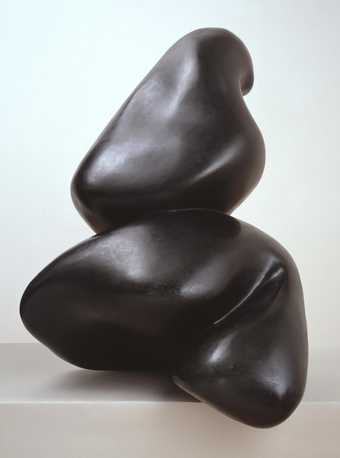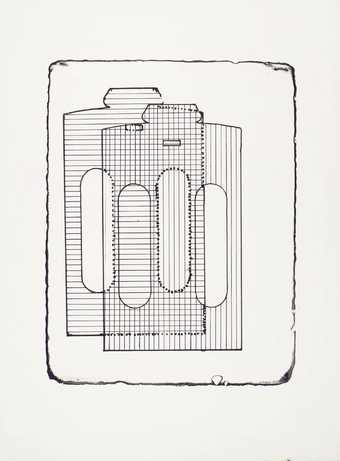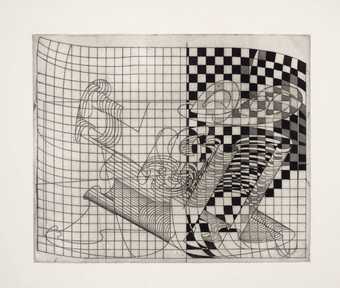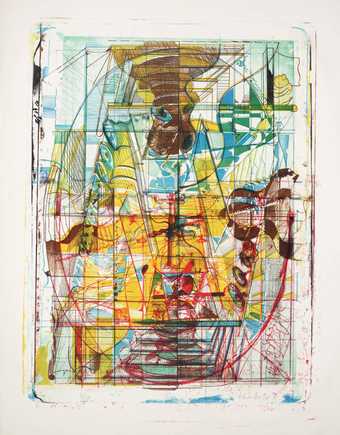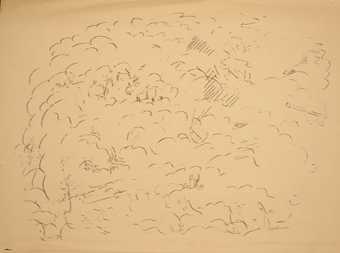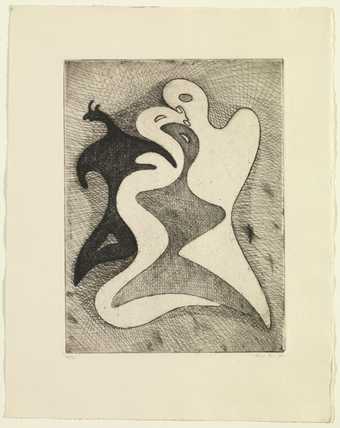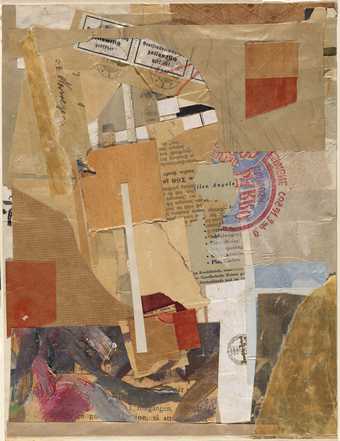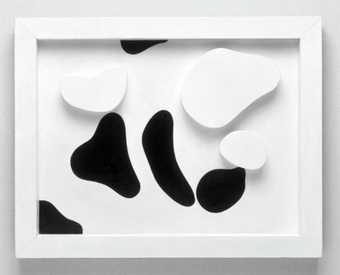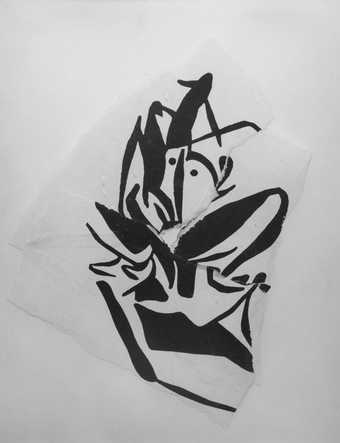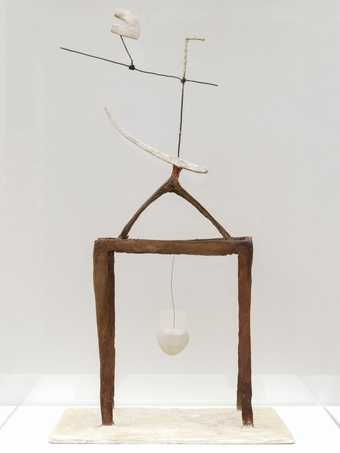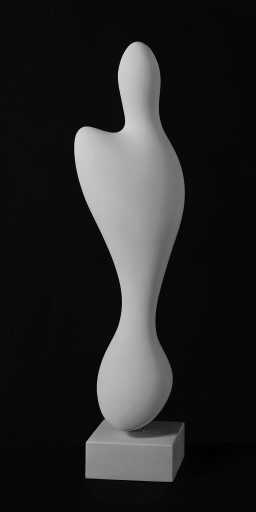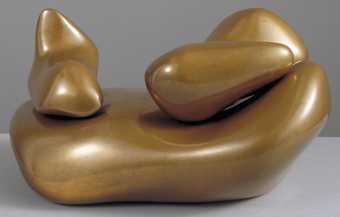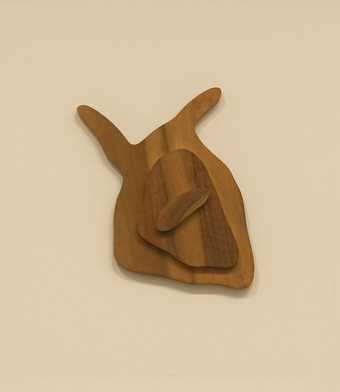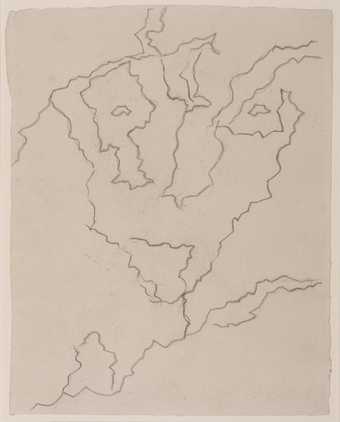
Not on display
- Artist
- Jean Arp (Hans Arp) 1886–1966
- Original title
- Selon les lois du hasard
- Medium
- Sugar paper on plyboard
- Dimensions
- Support: 159 × 173 mm
Frame: 404 × 420 × 205 - Collection
- Tate
- Acquisition
- Presented by Mr and Mr Robert Lewin through the Friends of the Tate Gallery 1987
- Reference
- T05005
Display caption
Arp felt that he could incorporate chance within artistic production, comparing the role of the artist to a plant bearing fruit. According to the Laws of Chance shows Arp playing with random composition, in this case dropping painted pieces of paper onto a surface. Torn Woodcut was made in a similar way in 1954, using the pieces of a Dada print he had made in 1920.
Gallery label, April 2008
Does this text contain inaccurate information or language that you feel we should improve or change? We would like to hear from you.
Catalogue entry
T05005 According to the Laws of Chance 1933 Selon les lois du hasard
Collage of black sugar paper on off-white one-ply board 159 × 173 (6 1/4 × 6 7/8)
Inscribed ‘Arp’ on back b.l. and ‘Arp’ on label removed and now separately preserved
Presented by Mr and Mrs Robert Lewin through the Friends of the Tate Gallery 1987
Prov: Bt from artist by Galerie Cramer, Geneva, by Jan. 1961, when exhibited; bt Brook Street Gallery (Robert Lewin) by July 1961 when exhibited
Exh: Galerie Cramer, Geneva, Jan. 1961 (21, cat. not found); Drawings and Sculptures, Brook Street Gallery, July–Aug. 1961 (7); Drawings by Sculptors, Scottish National Gallery of Modern Art, Edinburgh, April–May 1967 (3); Surrealism, Durham Festival, Durham, Nov.–Dec. 1968 (no cat. found); Hans/Jean Arp: Le Temps des papiers déchirés, Musée national d'art moderne, Centre Georges Pompidou, Paris, Jan.–March 1983 (18, repr. p.50, as ‘Papiers déchirés “selon les lois du hasard”’); Hans/Jean Arp: Papiers Déchirés and Related Works, Museum of Modern Art, Oxford, May–July 1983 (no number)
This is one of a number of similar collages executed by Arp in 1932 and 1933. In all of them small, irregularly shaped pieces of black paper are glued onto white paper or card. The reference to chance in many of the works’ titles suggests that Arp may have let the pieces fall onto an already glued surface, although the placing of the paper pieces in T05005 appears quite controlled, with none overlapping and some just touching.
It is not clear when T05005 acquired its current title. The majority of Arp's collages of this type are known simply by the generic title of ‘papiers déchirés’, literally, ‘torn papers’. It seems that sometime after he had executed them, Arp noted on the back of his three earliest ‘papiers déchirés’ that they were the first, second and third of the series, but he did not give the works titles as such. As the 1983 Centre Pompidou exhibition catalogue shows, there are other works of this group which have acquired interpretative titles, for example, ‘Nombril et nombril ailé’ (Mme Ruth Tillard-Arp, no.12) and ‘Les Doigts’ (private collection, no.23). Although it is unlikely that Arp himself titled T05005, a Galerie Cramer label on the back of the work indicates that it was known as ‘Selon les lois du hasard’ at least by 1961 when purchased by Robert Lewin.
Arp's ‘papiers déchirés’ of 1932–3 were a development of his ‘papiers collés’, or paper collages, of the mid-to late 1910s. He abandoned traditional oil painting in 1915, and worked instead with embroideries, tapestries and ‘papiers collés’. His first paper works had relatively complex shapes, arranged in dynamic configurations, but he quickly adopted a simplified vocabulary of rectangles. In this period, during which he is known to have read pre-Socratic philosophy and to have been influenced by Eastern mysticism, Arp employed notions of chance and flux in his work in protest at what he saw as the Western world's over-reliance on reason. Some of these early works - which were often executed in collaboration with Sophie Taeuber, whom he married in 1922 - were also entitled ‘according to the laws of chance’ (see, for example, ‘Elementary Construction “According to the Laws of Chance”’, 1916, Kunstmuseum, Basle, repr. Paris exh. cat., 1983, p.8 no.3). In 1948 he described these early works as, ‘Realities, pure and independent, with no meaning or cerebral intention’. He claimed that he and Sophie Taeuber had ‘rejected all mimesis and description, giving free reign to the Elemental and the Spontaneous’. ‘Since the arrangement of planes and their proportions and colours seemed to hinge solely on chance, I declared that these works were arranged “according to the laws of chance”, as in the order of nature, chance being for me simply a part of an inexplicable reason, of an inaccessible order’ (‘Dadaland’, in Marcel Jean, ed., Jean Arp: Collected French Writings, 1974, p.232).
In using the phrase ‘according to the laws of chance’ Arp did not mean to suggest that he composed his works randomly but, rather, that he did not work according to any premeditated or fixed plan. In a manuscript written in his last years and found among his belongings after his death, he underscored the distinction he drew between chance and randomness. ‘In the gibberish with which people happily augment the confusion, the word chance’, he wrote, ‘is used very much like senselessness. I have never called my works “according to the law of senselessness”’ (quoted in Arp 1886–1966, exh. cat., Minneapolis Institute of Arts 1987, p.196).
A formal and thematic model for this group of works on paper can be found in the series of wooden reliefs known as ‘Constellations’, executed in 1929–30. Among them is ‘Constellation According to the Laws of Chance’, 1930 (T00242), which, with its seemingly random arrangement of biomorphic elements and reliance of the non-colours white and black, can be seen as closely related to T05005. However, it seems that Arp's invention of ‘papiers déchirés’ was triggered less by any formal concerns than by a new preoccupation with mortality. The death of his mother in May 1929 had distressed him greatly, and in 1929–30 he explored the theme of death in such writings as ‘Das Tagesgerippe’ and ‘Träume vom Tod und von Leben’. According to his own testimony, however, it was the shock of the discovery of damage done to early collages by poor storage conditions in his own house that, above all, led to the ending of his pursuit of perfection and triggered the new series of works:
The search for an unattainable perfection, the delusion that a work could be completely finished, became a torment. I cut the papers for my collages with extreme precision and smoothed them down with a special sandpaper. The slightest loose thread or fiber was intolerable to me. The tiniest crack in a bit of paper often led me to destroy a whole collage. This frenzy ended in a tragedy when I was asked to exhibit some old collages I had done in collaboration with Sophie Taeuber ... We brought down the collages from the attic where they had been exposed for years to heat, cold, and dampness. Some of the papers had come unstuck, they were covered with spots, mould, and cracks, and between paper and cardboard blisters had formed that looked more loathsome to me than the bloated bellies of drowned rats. When after weeks of confusion I had calmed down a bit, I began to tear my papers instead of cutting them neatly with scissors. I tore up drawings and carelessly smeared paste over and under them. If the ink dissolved and ran, I was delighted. I stuck my collages together with a wad of newsprint instead of pressing them carefully with blotting paper, and if cracks developed, so much the better; as far as I was concerned, it made my work more authentic. I had accepted the transience, the dribbling away, the brevity, the impermanence, the fading, the withering, the spookishness of our existence. Not only had I accepted it, I had even welcomed transience into my work as it was coming into being. These torn pictures, these papiers déchirés brought me closer to a faith in things other than earthly.
(‘Looking’, 1958, in James Thrall Soby, ed.,
Arp, exh. cat., Museum of Modern Art,
New York 1958, pp.15–16)
In T05005 notions of decay and dissolution are suggested by the feathery edges and softness of the sugar paper (small black paper fibres, which were lost from the paper pieces as they were being placed on the glued surface of the mount, are plainly visible). The seemingly unordered placement of the pieces, suggesting a lack of struggle or tension, may perhaps be seen as a metaphor for the state of death. As in the ‘Constellation’ series, the use of the non-colours black and white focus attention on the elements’ contours, and the contrast of ‘being’ and ‘non-being’.
Arp made a few ‘papiers déchirés’ later in his career. ‘Torn-up Woodcut’, 1954 (T01219), is one such work in which Arp used pieces of a woodcut made in 1920. Towards the end of his career he came to feel that his early ‘papiers déchirés’ had prefigured the ‘all-over’ style of painting of American Expressionist art. In 1958 he wrote, ‘I exhibited [‘papiers déchirés’] for the first time in 1933 in Jeanne Bucher's gallery in Paris, and most of them found their way to the United States. I believe that they represent the transition from abstract painting to “liberated painting”, as I should like to call the new American painting’ (ibid., p.16).
Published in:
Tate Gallery: Illustrated Catalogue of Acquisitions 1986-88, London 1996
Explore
- abstraction(8,615)
-
- non-representational(6,161)
-
- irregular forms(2,007)
- monochromatic(722)
- formal qualities(12,454)
-
- chance(1,450)
- defacement(257)
- fragmentation(233)
You might like
-
Jean Arp (Hans Arp) Pagoda Fruit
1949 -
Dieter Roth Hemdenstein
1971 -
Dieter Roth Quartet
1971 -
Dieter Roth Double Quartet
1971 -
Dieter Roth Scrabble
1971 -
Max Ernst Dangerous Correspondances
1947 -
Kurt Schwitters Opened by Customs
1937–8 -
Jean Arp (Hans Arp) Constellation According to the Laws of Chance
c.1930 -
Jean Arp (Hans Arp) Torn-Up Woodcut
1920–54 -
Alberto Giacometti Hour of the Traces
1932 -
Jean Arp (Hans Arp) Winged Being
1961 -
Jean Arp (Hans Arp) Sculpture to be Lost in the Forest
1932, cast c.1953–8 -
Jean Arp (Hans Arp) Impish Fruit
1943 -
Jean Arp (Hans Arp) Danger of Death
1954 -
Jean Arp (Hans Arp) Moustaches
c.1925

